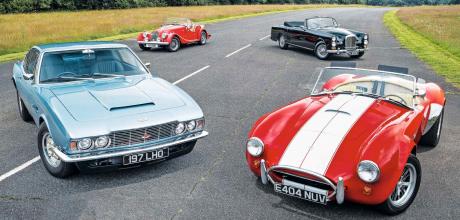1989 Morgan 4/4 vs. 1965 Alvis TE21 Convertible, 1987 AC Cobra MkIV, 1970 Aston-Martin DBS V8
Which British classics offer the most hand-built character for the money in today’s market? Let’s explore our four choices: Morgan 4/4, Aston Martin DBS V8, Alvis TE21 and AC Cobra MkIV. Words Andrew Noakes. Photography Jonathan Fleetwood.
‘Germans do efficiency, Italians do style. But Brits do painstaking traditional craftsmanship
From tourers to sports cars, which handcrafted Brit is for you?
The Big Test Handcrafted Brits
Germans do efficiency, Italians do style. Americans are obsessed with cubic inches, the French with doing things in their own particular way. The British? Despite the millions of Minis, Marinas and Cortinas that have rolled off mechanised production lines, at its heart, specialist British car making has always been about the painstaking art of traditional craftsmanship.
All that effort and skill tends to come at a price for the first owner, but years later they can look better value. We’ve brought four appealing buys to a Surrey test track to find out what you get for your money. Between them the Morgan 4/4, Alvis TE21, Aston Martin DBS V8 and AC Cobra MkIV offer a choice of sports tourer, GT and no-frills performance car, with values from under £25,000 to over £150,000. It’s a tempting bunch and I can’t wait to see which delivers the most soul and character.
1989 Morgan 4/4
I’m starting with the Morgan 4/4, which proves that a hand-made car doesn’t have to come with a gold-plated price tag. Its throwback styling is staunchly, deliberately traditional and remained virtually unchanged since 1954, when cars with the familiar rounded grille started rolling out of the Malvern factory. In fact ours is a late Eighties car, with the wider bodywork that was standard on the more expensive Plus 4 and an option on the 4/4. The core of the body is the same on both but the wings were trimmed along their inside edges before they were fitted on narrower cars.
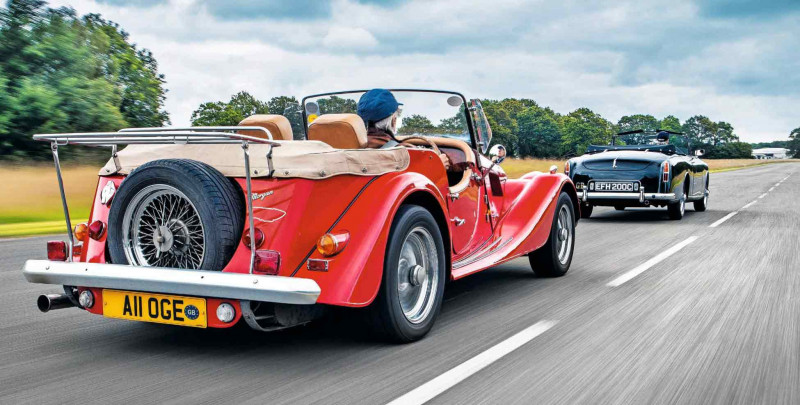
The driver’s eye level is barely higher than the top of that long, slim, side-opening bonnet, so the view ahead through the upright screen is dominated by rows of louvres stretching away into the distance. The simple, veneered wood dashboard and traditional round instruments add to the charmingly retro feel.
I sit in a flat seat, trimmed in beige leather bearing the patination of more than 30 years’ use, and wedged between a slim, low-cut door and a carpeted transmission tunnel. On top of the tunnel is the biggest giveaway that this isn’t a car from the Thirties – a black plastic Ford Sierra gear lever with markings for five ratios.
There’s a Ford gearbox underneath, mated to a Ford engine. Most 4/4s have blue-oval motive power, though Coventry Climax, Standard and even Fiat Twin Cam units were used at various stages in the model’s long production life. The 1.6-litre CVH engine we have here, breathing through a twin-choke Weber, is basically a Fiesta XR2/Escort XR3 engine adapted for inline installation. It’s not the smoothest or gutsiest straight four, but it responds crisply to throttle inputs, pulls with an enthusiastic thrum, and its 96bhp is enough to give the featherweight Morgan entertaining performance. Revised springs and dampers – a common Morgan mod’ – have smoothed out the ride on this car, and it corners flat and accurately. But there’s a limit to what the basic suspension layout can achieve and the wood-rim wheel weights up as it’s turned away from the centre in a very vintage manner. Is that an irritation, or another appealing character trait? Whichever you think, the Morgan is a fun way to barrel down a B-road, with the eager four humming away up front and the wind whipping around the very open cockpit.
The 4/4 came in two- and four-seater form, the latter swapping the two-seater’s sloping rear body section for an upright rear end housing a small child-friendly bench seat. There seems to be little difference in value between two and four-seaters, good examples often selling for around £25,000 or more – though a tidy mid-Nineties 4/4 recently sold at auction for less than £21,000. Major mechanical problems are minimised by tough, ubiquitous drivetrains; paint and corrosion protection are less certain.
Paintwork improved in the late Eighties but earlier cars can suffer from paint cracks where wings meet the body because they were painted in situ; they were later painted individually. A galvanised chassis wasn’t available until 1987 and only became standard in 1995, and they can suffer from corrosion. Bodywork was framed in ash and Cuprinol rotproofing was only standard from 1987, so tired cars can suffer from structural issues. Check under the carpets, doors, sill boards, door hinge posts, and rear number plate mounting for signs of moisture. Lack of use can lead to seized brakes and leaky master cylinders. Fortunately most Morgans are well kept, and they’re easy to strip and rebuild.
‘96bhp is enough to give the featherweight Morgan entertaining performance’
Owning a Morgan 4/4
Morgan 4/4 owner Stephen Bridge recalls, ‘I drove quite a few, and I’d seen a lot of rubbish. I got this one in 2004 from a Morgan specialist in Worcester. They’d looked after it and knew all about it. The suspension is quite primitive at the front and you could feel each and every bump before I made some improvements. ‘Occasionally I contemplate a Plus 8 with a big Rover engine or a go-faster Plus 4, but then I think of the practicalities. I go to Le Mans every year, I fill the back seat with the camping gear, and I take four people into the circuit in it. I can do the supermarket shopping – you can’t do that in a two-seater. I’ve had a couple of problems with the cooling and fan while queuing in the traffic at Le Mans. I had the water pump replaced (£261) and the radiator repaired (£560). I also had to have the differential reconditioned (£890) because an internal spring broke, but that’s been about it.’
1989 Morgan 4/4
- Engine 1598cc inline four-cylinder, sohc, Weber 32/34DMTL carburettor (pre-1987), 28/32TDLA (from 1987)
- Max Power 96bhp @ 6000rpm
- Max Torque 98lb ft @ 4000rpm
- Transmission Ford five-speed manual gearbox, rear-wheel drive
- Steering Rack and pinion
- Suspension
- Front: independent, sliding pillar, coil springs, telescopic dampers
- Rear: live axle, leaf springs, telescopic dampers
- Brakes Front: discs; rear: drums Servo-assisted
- Performance; 0-60mph: 9.0sec
- Top speed: 106mph
- Weight 735kg (two-seater), 760kg (four-seater)
- Fuel consumption 30mpg
- Cost new (four seater) £13,798 in 1989
- Classic Cars Price Guide £12,500-£26,000
Eager throttle response boosts the Morgan’s driving appeal. Ford CVH engine shared with Fiesta XR2 and Escort XR3.
1965 Alvis TE21 convertible
The Alvis TE21 at our disposal today is a picture of elegance, with restrained lines and flawless black coachwork providing a background for the exterior chrome detailing to stand out. The quad headlamps in two stacked pairs flanking the tall chrome grille give the TE real road presence from the front. Those lamps were the most noticeable difference from the 1958-1963 TD and were carried over to the TF in 1966.
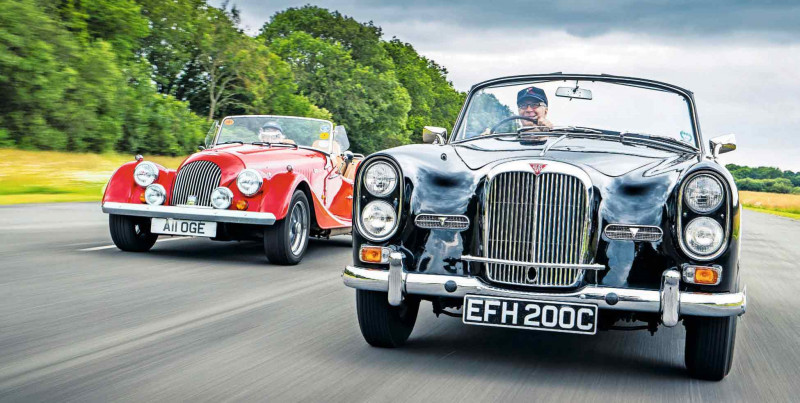
Enter the cabin through the wide, heavy door and the Alvis surrounds you with quality and good taste. The soft seat cocoons you in fluted grey hide, while up ahead more leather edges a traditional dashboard faced in rich caramel-coloured veneer. The speedometer and tachometer are grouped in the centre of the dashboard either side of the clock – as on the TD; the TF moved them to a new binnacle in front of the driver – with heater controls and a Radiomobile wireless below, leaving space for generous cubby hole on the driver’s side.
The big steering wheel, with a proud Alvis eagle on the boss, a wood rim and three sprung spokes, is barely more than elbow distance from my chest. It operates steering which is a touch vague at the straight ahead position, but pleasantly direct and always light thanks to hydraulic power assistance. Grip from the period-style Dunlop crossply tyres is far from tenacious, but the Alvis is well balanced and the car is lighter than it looks, so it changes direction more adroitly than you might expect.
It goes well, too. The seven-bearing, 3.0-litre straight-six was introduced in the TA21 of 1950 developing just 85bhp, but more power came as the improving quality of fuel in post-war Britain allowed successive rises in compression ratio, and carburetion improved with twin SUs. Output was increased to 115bhp in the TD and ultimately 150bhp in the TF, still with the same capacity but with three SUs – though the extra power of the triple-carb’ unit came at the expense of some of its inherent smoothness.
The TE has a twin-carb’ version of the engine, with bigger valves than the TD and revised exhaust manifolding, which makes a useful 130bhp and delivers it with impeccable refinement. With a light, positive gearchange and pedals perfectly arranged for heeling and toeing, it’s easy to keep the engine in its sweet spot around 3000rpm, a musical exhaust thrum accompanying the acceleration. Back off to a cruise and the noise level drops appreciably.
It’s clear that this is a car that’s built for covering long distances in refinement and comfort. The suspension is firm enough to maintain stability but with a suppleness that soaks up the worst of the road’s irregularities, and with the well-insulated roof raised the interior is as snug as any saloon car’s.
Like so many specialist car makers Alvis never built its own bodies, relying instead on coachbuilders like Tickford in Newport Pagnell, Mulliners in Birmingham and the Swiss firm Graber. Alvis employed Willowbrook of Loughborough to make bodies based on Graber’s styling before switching to Park Ward for the TD, TE and TF. Despite the aristocratic provenance of the bodywork – Willesden-based Park Ward had been owned by Rolls-Royce since 1939 – corrosion is a major problem. Bonnet, boot lid and doors are aluminium but the rest of the bodywork is steel, and rust is particularly prevalent in double-skinned areas such as the wheel arches. The sills and boot floor are other favourite corrosion spots, and rectification can be expensive – full restoration of the handbuilt body could easily run to £35,000.
Sadly the rust problems don’t end there. The separate laddertype chassis is also susceptible, particularly at the mounting points for the front and rear suspension, the outriggers and the rear crossmember. Mechanically the cars are strong and cover high mileages without complaint. Support is excellent, led by Red Triangle which took over the factory’s parts stock, records and technical drawings when Alvis ended car manufacturing in 1967. Today a manual TE21 drophead like this one could fetch around £130,000, reflecting its rarity – only 98 were built, and happily most of them are thought to survive. An even rarer but less desirable automatic drophead sold at auction last year for £50,625, while the more common TD/TE/TF saloons deliver much of the same experience from around £25,000.
‘Only 98 were built, and happily most of them are thought to survive’
Twin carb’ Alvis six-cylinder has impeccable refinement. Stylish interior blends quality wood and leather. Four-headlamp front end was new for the TE in 1963.
Owning an Alvis TE21
‘It was restored by Red Triangle for the 1989 NEC Classic Car Show,’ says Mark Seligman of his TE21. ‘It’s got the ZF five-speed manual gearbox and goes quite well if you push it, but it’s a touring car. It’s taken us down to France a few times, and up to the north of Scotland.’
Mark’s 30-plus years of ownership haven’t been troublefree, ‘It’s definitely the least reliable car I’ve owned, though it has only left me stranded twice in 32 years. Today the indicators have packed up and the power steering pump is leaking. Over the years almost everything has played up – lights, pumps, radiators, steering, brakes. The exhaust manifold is on the same side as the carburettors which causes endless problems with fuel vaporisation. But the engine itself is strong, smooth and powerful. By the time they put three carburettors on it on the TF it was no longer as smooth. So I think it’s the most desirable of the Alvises.’
1965 Alvis TE21 convertible
- Engine 2993c inline six-cylinder, ohv, two SU HD6 carburettors
- Max Power 130bhp @ 5000rpm
- Max Torque 172lb ft @ 3250rpm
- Transmission ZF five-speed manual or Borg-Warner three-speed automatic, rear-wheel drive
- Steering Power-assisted ZF recirculating ball
- Suspension
- Front: independent, wishbones, coil springs, telescopic dampers, anti-roll bar
- Rear: live axle, leaf springs, telescopic dampers
- Brakes Servo-assisted discs all round
- Performance 0-60mph: 12sec (est.)
- Top speed: 110mph
- Weight 1588kg
- Fuel consumption 20mpg
- Cost new £3016 in December 1964
- Classic Cars Price Guide £37,500-£89,000
1987 AC Cobra MkIV
The AC Cobra MkIV was an Eighties revival of AC’s most famous car. Brian Angliss’s Autokraft concern at Brooklands bought AC’s original body tooling and made the Autokraft MkIV, securing agreement to use the AC Cobra name in April 1986 which came, for a while, with financial backing from Ford. This MkIV looks virtually identical to a Sixties Cobra from the outside, though the body lines around the cockpit are subtly different to improve passenger space.
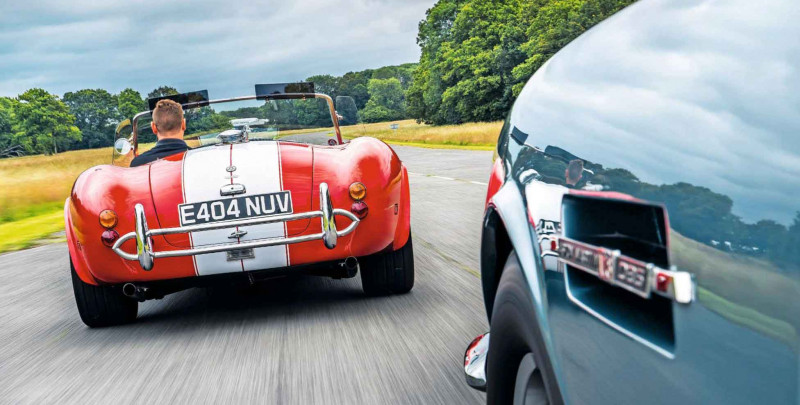
This car was supplied new to the US where it would have had to wear Federally mandated rubber bumpers to go along with its side marker lamps. Inside there’s a mixture of ancient and modern, the leatherclad dashboard carrying generic Smiths instruments with thentrendy matt-black bezels instead of classic chrome, a Triumph Dolomite warning light cluster, and heater controls from a Mercedes W123. It’s a combination that looks more cohesive than it sounds, but it’s not as attractive to my eye as the MkIII-style dash that many MkIV owners have retrofitted.
Under the skin the major change was a new version of the venerable small-block Ford V8. While Shelby in the US had ultimately fitted big-block 7.0-litre engines into its Cobras, AC’s own cars had used the 289 cubic inch (4.7-litre) small block. The MkIV adopted a slightly longer-stroke version which Ford badged as a 5.0-litre, though it was actually 4942cc. The four-barrel carburettor was replaced by electronic fuel injection and there was a catalysed exhaust, the result being a cleaner Cobra but one that was also smoother and quieter. Those were qualities that some buyers felt didn’t really fit its character, so the factory soon offered carburettor conversions and open exhausts for additional rort.
Still, fire up this fuel-injected V8 and the Cobra comes alive, the whole car vibrating to every blip of the throttle. Too much is never enough, I suppose, but even this relatively restrained example has unrivalled aural and visceral impact.
This Cobra a physical thing to drive. The brake and clutch pedals both need a good deal of exertion and swapping cogs in the Borg- Warner T5 gearbox demands positive, punchy movements of the tall lever with its characteristic forward lean. The dainty wood rim and alloy spokes of the steering wheel are misleading, because the Cobra is a car you need to heave with your arms and shoulders rather than caress with your fingertips.
Or, if you’re braver, use your right toe – in the lower gears the V8 has more than enough torque to break traction and get the tail moving around. With 250bhp on tap and only a little more than a tonne to motivate, the Cobra is never short of performance. But if you’re not in the mood it’s just as happy to adopt a more relaxed style of driving. The injected V8 is flexible enough to burble around at low revs in fifth gear without any complaint.
These are strong, well-built machines and the problems that arise are invariably through lack of use – batteries fail and brakes stick. Cars that do get used will need regular attention to the Rose-jointed suspension, because the joints rarely last more than 6000 miles. Play leads to tyre wear and inconsistent handling, but thankfully replacing the joints is not difficult. Well-used cars are likely to suffer from paint chips on the curvaceous front end.
The engine and gearbox are strong and easy to maintain. On injection cars check for damage to the exhaust and catalyst because of the tight ground clearance. Look for leaks from the radiator which can allow coolant to collect in the front chassis crossmember.
Almost all parts are available, though the black plastic dash switches aren’t and tend to fade. Make sure the weather equipment is present because it often gets removed and stored separately. It’s tailored to fit the individual vehicle and replacing the complete kit – hood, sticks, tonneau and side screens – can cost £7000.
MkIV values have been slowly rising for years. Five years ago these cars remained unsold at auctions for £80,000 or less, but our car is on sale for £99,700 through specialists Redline, which says finding buyers these days is much easier than finding cars to meet demand. The value is as dependent on tasteful modifications like a tuned engine or the popular MkIII dashboard conversion (which not only makes the car look more classic but also frees up more space in the footwells) as it is on overall condition and history.
‘It’s a car you need to heave with your shoulders rather than caress with fingertips’
Cobra MkIV is a blend of classic style with updated mechanical parts Small-block V8 has electronic fuel injection as standard. Matt black switches and bezels betray Eighties origins.
Owning an AC Cobra MkIV
Neil Fisher worked at the factory in period and now runs Cobra specialist Redline Engineering (redlineclassiccars.co.uk). He says, ‘MkIVs often went back to Autokraft for improvements soon after they were registered. To get through Type Approval it was muffled, detuned, didn’t sound inspiring. It would go back and all the goodies would go on it to make it look and sound like a proper car. This one, apart from the fuel cap and the steering wheel, is as it came out of the factory. The reputation Autokraft had for their build quality was huge. We don’t get a lot in needing sills or outriggers. This one still has its original paint. We had a car in last year for its first new clutch at 77,000 miles. It’s an easy, usable car – pretty unstressed, easy to drive and enjoy. The hood’s a bit of a palaver to put on, but it’s dry, and there’s a pretty good boot – the other half can be unrestricted with their packing!’
1987 AC Cobra MkIV
- Engine 4942cc V8, ohv, Ford fuel injection
- Max Power 250bhp @ 4200rpm
- Max Torque 300lb ft @ 3200rpm
- Transmission Borg-Warner five-speed manual gearbox, rear-wheel drive
- Steering Rack and pinion
- Suspension
- Front: independent, unequal length wishbones, coil springs and telescopic dampers, anti-roll bar
- Rear: independent, unequal length wishbones, coil springs and telescopic dampers
- Brakes Servo-assisted ventilated discs all round
- Performance 0-60mph: 5.2sec
- Top speed: 155mph
- Weight 1153kg (2540lb)
- Fuel consumption 20mpg
- Cost new £30,000 in 1984
- Classic Cars Price Guide £60,000-£99,500
1970 Aston DBS V8
While the Alvis and AC names are virtually unknown today outside enthusiast circles, Aston Martin is enjoying a renaissance under new ownership and back in top-level motor sport. The Aston DBS V8 of the late Sixties/early Seventies has never had it so good either, buoyed up in value by Bond-fuelled enthusiasm for the DB4/5/6 that preceded it and the post-David Brown V8s that came after.
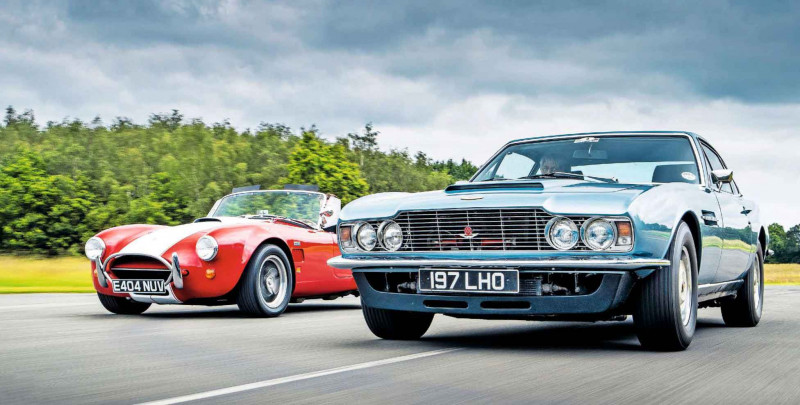
The later cars have the more familiar two-headlamp front end, but the intricate four-lamp nose of the DBS, as originally intended by William Towns, has aged well. It gives the DBS V8 an air of solidity and confidence that permeates the whole car. Pull open the big door and settle into the driver’s seat and you find quality materials and a restrained, business-like aesthetic with no fripperies like add-on wood trim. It’s almost austere, though Aston backtracked on the later V8s, adding wood to make the interior more welcoming. That no-nonsense vibe is just as much in evidence when you drive.
The DBS is firmly sprung but never uncomfortable, stable and surefooted without being leaden. The driving position is straightforward and it’s an easy car to position on the road. Power assistance takes the effort out of twirling the leather-wrapped steering wheel, but avoids the disconnected feel of a contemporary Jaguar. Instead there’s just consistent weighting, modulated by feedback telling you what the front tyres are up to. Clutch and brake both need a firm push and the dog-leg ZF gearbox has a weighty, long-throw change – the combination can make the DBS feel ponderous at low speeds – but pick up the pace and it all starts to make more sense. The big V8 is the star of the show. After an abortive debut in a pair of Lolas at Le Mans the engine was comprehensively redesigned, with such success that it became Aston Martin’s mainstay for the next three decades. It idles with a subdued burble and at low revs there’s a characteristic V8 rumble, but blip the throttle to change down and you realise there’s more to this motor than just lazy cubic inches. Response is immediate, and it pulls with vigour from just 2500rpm, the DBS squatting down over its de Dion rear end and punching forwards to the horizon with real authority. The closer you let the Aston V8 get to the red sector on the tacho, starting at 6000rpm, the more mellow and confident it sounds.
They’re strong engines, but the alloy cylinder block can suffer from internal corrosion which disturbs the O-rings sealing the steel liners, leading to oil and coolant leaks. The injection system needs to be carefully set up and can suffer from vapour lock which makes the engine hard to start when hot. Some owners fit an over-ride switch to allow the cold-start enrichment system to be operated when the engine is hot, clearing the vapour lock. Both the ZF manual gearboxes and Chrysler TorqueFlite automatics are robust and rarely give trouble. Suspension bushes and brakes wear rapidly on hard-driven cars, leading to sloppy road manners.
But it’s corrosion of the structure that is the biggest worry. Although the outer body panels are aluminium, the DBS is based on a hefty steel platform chassis and rust can attack the sills and floor panels. Cutting out the rot, rebuilding and repainting is likely to cost at least £6000 per side and may well reveal further necessary work. But with prices rising, DBS V8s are starting to repay that sort of investment. Ten years ago auction prices topped out around £80,000, whereas now values over £100,000 are common and we’ve seen good cars making £150,000 or more.
These four cars all have an indefinable magic ingredient that comes from being built by time-served craftsmen rather than faceless robots, but each one offers something a bit different to the others. The Morgan has a homely, folksy charm, while the Cobra’s appeal is altogether more raw and animalistic. The Alvis is at the opposite end of the spectrum as the last word in elegance and class. But my vote has to go to the Aston, which effortlessly justifies what in this company is a high price with its unrivalled blend of power, panache, accomplished road manners and suave good looks. But whichever you pick, you’re assured of a car brimming with character that’s been built into it by automotive artisans.
‘The closer you get to the red sector on the tacho, the more mellow it sounds’
Handsome Aston V8 is fuelled by Bosch injection High-quality materials used but no frills in the DBS V8 interior Four-lamp DBS front end has aged impressively.
Owning an Aston Martin DBS V8
‘I had a DB6 Mk2 then went looking for a DBS V8, a bit of a project and something I could put some value into,’ says Kai Barnett. ‘The previous owner campaigned it in sprints and hill climbs, but it was a bit tatty – he transported his tyres in it, and you could read the tyre maker’s names on the headlining. It went down to a bare-metal respray. I don’t like overly restored cars and wanted to keep some of its character, so we put it back to its original colour – there were only five made in Celeste blue. ‘There’s continual stuff you have to do because it’s a 50-year-old car. The early injection cars can go off tune, and they can vapour lock when hot. You can modify the cold start system to clear it, a cheap but fiddly job. The brake master cylinder and a servo have died, but fortunately I had spares. It’s not perfect but it’s usable. The DBS V8 is totally different from a DB5 or DB6 – it does bring out the hooligan in you.’
1970 Aston DBS V8
- Engine 5340cc V8, dohc per bank, Bosch mechanical fuel injection
- Max Power 345bhp @ 6000rpm
- Max Torque 360lb ft @ 4000rpm
- Transmission ZF five-speed manual or Borg-Warner three-speed automatic
- Steering Power-assisted rack and pinion
- Suspension
- Front: independent, double wishbones, coil springs, telescopic dampers, anti-roll bar. Rear: de Dion, trailing arms, Watt linkage, coil springs, telescopic dampers
- Brakes Servo-assisted vented discs all round, inboard at rear
- Performance 0-60mph: 6sec;
- Top speed: 170mph
- Weight 1725kg
- Fuel consumption 18mpg
- Cost new £7501 in 1970
- Classic Cars Price Guide £59,000-120,000
‘Skilled work like this takes time, but it’s nowhere near as expensive to own as you might think’
EDITOR PHIL BELL SAYS
‘Parts-bin spotters love to use them as a point of criticism but I admire the way that hand-built manufacturers incorporate mass-market parts so cleverly that they look as if they were designed for the car. Take the taillights on the Aston and Alvis, both from Rootes products and both used with great sensitivity on other low-volume cars too. ‘I also love the details, features that would be too difficult or expensive to body engineer into a volume-built car. The way the Aston Martin V8 strake floats across the its vent is the sort of thing that would give pleasure every time you leather the car off after washing it. Delightful.’
PRODUCTION EDITOR JOE
BREEZE SAYS ‘Old British cars are revered (and occasionally mocked) for their frequent use of leather and wood inside, the latter invariably veneered with time-honoured techniques. But it was under the skin that craftsmanship endured. While much of industry abandoned ash-framed bodies in the Thirties, Morgan and certain British coachbuilders – including those who bodied Alvises – perservered and perfected the craft over subsequent decades. ‘Enamel badges were another feat of craftsmanship, particularly when they were required to curve with bodywork contours. Creating one with traditional jeweler-inspired methods would take up to 20 hours.
NEWS EDITOR SAM DAWSON
SAYS ‘For me, a crucial feature of a traditional British coachbuilt car is the dazzle and curve of wheeled aluminium. The traditional Italian approach to shaping aluminium involves beating it into shape with a hammer over a sandbag, leaving dimples all over the inside. But when fed through a wheeling machine in the British style, you get a beautifully smooth curve that reflects the light back exquisitely. Skilled work like this takes time, but the beauty of it is that it’s nowhere near as expensive to own as you might think, thanks to Morgan’s retention of these old techniques within relative mass production. Thankfully some things never change.’
Thanks to: Redline Engineering (redlineclassiccars.co.uk), Morgan Sports Car Club (morgansportscarclub.com), Alvis Owner Club (alvisoc.org), Red Triangle (redtriangle.co.uk), Aston Martin Owners Club (amoc.org)


